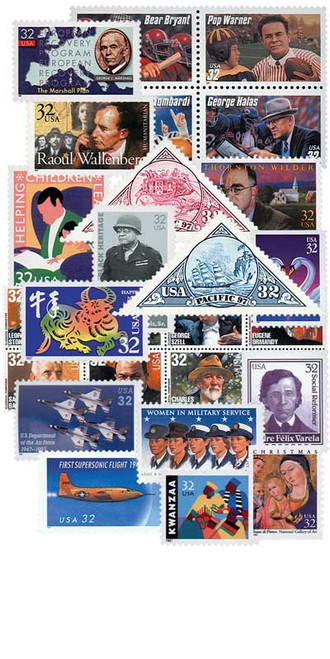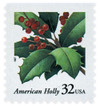
# 3177 - 1997 32c Contemporary Christmas: American Holly
US #3177
1997 American Holly (single) – Contemporary Christmas Series
- Issued in panes of 20 and booklets of 15 or 30
- Part of the Contemporary Christmas Series
Stamp Category: Commemorative
Series: Contemporary Christmas
Value: 32¢, First Class Mail Rate
First Day of Issue: October 30, 1997
First Day City: New York, New York
Quantity Issued: 1,306,000,000 (Pane of 20); 135,165,000 (Booklet of 15); 180,300,000 (Booklet of 30)
Printed by: Banknote Corporation of America
Printing Method: Offset
Format: Panes of 20, Booklets of 15, Booklets of 30
Perforations: 11.3 x 11.6 (die-cut simulated perforations) (die-cut circles and lines on non-stamp label)
Tagging: Phosphored paper
Why the stamp was issued: To celebrate Christmas with an image of a traditional decoration
About the stamp design: Pictures a piece of holly with red berries by Ned Seidler (previous artist for the 1993-96 Garden Flowers stamps, 1993 African Violets booklet, and 1995 Peaches and Pears booklet).
Special design details: The image on all three stamp versions (panes of 20, booklets of 15, booklets of 30) are identical, but there are some ways to tell which one an individual stamp came from:
- Die-cut simulated perforations on all four sides of the stamp – Pane of 20
- Straight edge at top or bottom but not either side – Pane of 20
- Straight edges on bottom and right sides – Booklet of 30
- Adjacent straight edges at top – Pane of 20 OR Booklet of 30
First Day City: The First Day of Issue Ceremony was held October 30th and marked the opening of the Postage Stamp Mega-Event sponsored by the American Stamp Dealers Association, American Philatelic Society, and USPS.
Originally intended for ATM use: The USPS originally intended the Holly stamps to be used in ATMs. However, officials were so pleased with how the design turned out, they felt it “wouldn’t receive the attention it deserved on an ATM stamp.”
About the Contemporary Christmas series: In 1966, the Post Office came up with a plan to produce Christmas stamps utilizing classic paintings of the Madonna and Child. These stamps wouldn’t violate the separation of church and state because they were a celebration of culture. On November 1, 1966, the first US Madonna and Child stamp was issued. It pictured the 15th century painting Madonna and Child with Angels by Flemish artist Hans Memling.
The stamp was very popular and over 1.1 billion were printed. The same design was used the following year, but on a larger stamp with more of the painting showing. The popularity of the stamp continued, leading the Post Office to issue another Traditional Christmas stamp in 1968, this time picturing the Angel Gabriel.
In 1969, the Post Office returned to a non-religious stamp theme, with Winter Sunday in Norway, Maine. The following year, to appease all audiences, the US issued one Traditional Christmas stamp of the Nativity and a block of four Contemporary Christmas stamps picturing Christmas toys. The decision proved popular and both Traditional and Contemporary Christmas series have continued ever since.
History the stamp represents: American holly, Ilex opaca, is actually a hardy evergreen tree which can grow as tall as 60 feet and can live up to 200 years. Its spiked green leaves and red berries shine through the winter months like a promise of life, and its boughs have been used as seasonal decorations since ancient times.
Evergreen branches made their way into most homes in mid-December during the ancient Roman festival of Saturnalia. This was when early Christians adopted the custom _ to avoid recognition and persecution. Since then, the use of holly at Christmastime has had religious significance in many legends.
It has been said that Christ’s crown of thorns was made of holly. Other stories say that the early French and English hung holly over each door to show that Christ was present in their homes.
According to one old wives’ tale, whoever brings holly into the house at Christmas, either husband or wife, will rule the house during the coming year. There are also legends about holly being used to guard against evil spirits and bad winter weather.
Along with all of its history and symbolism, perhaps the bright, festive appearance of American holly is what keeps it a familiar part of Christmas tradition.
US #3177
1997 American Holly (single) – Contemporary Christmas Series
- Issued in panes of 20 and booklets of 15 or 30
- Part of the Contemporary Christmas Series
Stamp Category: Commemorative
Series: Contemporary Christmas
Value: 32¢, First Class Mail Rate
First Day of Issue: October 30, 1997
First Day City: New York, New York
Quantity Issued: 1,306,000,000 (Pane of 20); 135,165,000 (Booklet of 15); 180,300,000 (Booklet of 30)
Printed by: Banknote Corporation of America
Printing Method: Offset
Format: Panes of 20, Booklets of 15, Booklets of 30
Perforations: 11.3 x 11.6 (die-cut simulated perforations) (die-cut circles and lines on non-stamp label)
Tagging: Phosphored paper
Why the stamp was issued: To celebrate Christmas with an image of a traditional decoration
About the stamp design: Pictures a piece of holly with red berries by Ned Seidler (previous artist for the 1993-96 Garden Flowers stamps, 1993 African Violets booklet, and 1995 Peaches and Pears booklet).
Special design details: The image on all three stamp versions (panes of 20, booklets of 15, booklets of 30) are identical, but there are some ways to tell which one an individual stamp came from:
- Die-cut simulated perforations on all four sides of the stamp – Pane of 20
- Straight edge at top or bottom but not either side – Pane of 20
- Straight edges on bottom and right sides – Booklet of 30
- Adjacent straight edges at top – Pane of 20 OR Booklet of 30
First Day City: The First Day of Issue Ceremony was held October 30th and marked the opening of the Postage Stamp Mega-Event sponsored by the American Stamp Dealers Association, American Philatelic Society, and USPS.
Originally intended for ATM use: The USPS originally intended the Holly stamps to be used in ATMs. However, officials were so pleased with how the design turned out, they felt it “wouldn’t receive the attention it deserved on an ATM stamp.”
About the Contemporary Christmas series: In 1966, the Post Office came up with a plan to produce Christmas stamps utilizing classic paintings of the Madonna and Child. These stamps wouldn’t violate the separation of church and state because they were a celebration of culture. On November 1, 1966, the first US Madonna and Child stamp was issued. It pictured the 15th century painting Madonna and Child with Angels by Flemish artist Hans Memling.
The stamp was very popular and over 1.1 billion were printed. The same design was used the following year, but on a larger stamp with more of the painting showing. The popularity of the stamp continued, leading the Post Office to issue another Traditional Christmas stamp in 1968, this time picturing the Angel Gabriel.
In 1969, the Post Office returned to a non-religious stamp theme, with Winter Sunday in Norway, Maine. The following year, to appease all audiences, the US issued one Traditional Christmas stamp of the Nativity and a block of four Contemporary Christmas stamps picturing Christmas toys. The decision proved popular and both Traditional and Contemporary Christmas series have continued ever since.
History the stamp represents: American holly, Ilex opaca, is actually a hardy evergreen tree which can grow as tall as 60 feet and can live up to 200 years. Its spiked green leaves and red berries shine through the winter months like a promise of life, and its boughs have been used as seasonal decorations since ancient times.
Evergreen branches made their way into most homes in mid-December during the ancient Roman festival of Saturnalia. This was when early Christians adopted the custom _ to avoid recognition and persecution. Since then, the use of holly at Christmastime has had religious significance in many legends.
It has been said that Christ’s crown of thorns was made of holly. Other stories say that the early French and English hung holly over each door to show that Christ was present in their homes.
According to one old wives’ tale, whoever brings holly into the house at Christmas, either husband or wife, will rule the house during the coming year. There are also legends about holly being used to guard against evil spirits and bad winter weather.
Along with all of its history and symbolism, perhaps the bright, festive appearance of American holly is what keeps it a familiar part of Christmas tradition.







